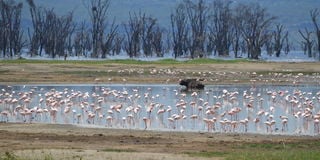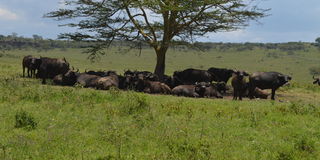Premium
COP27: Kenya should use destruction of Lake Nakuru to push its climate finance agenda

Flamingos at Lake Nakuru on October 5, 2022. The population of the birds has declined from 300,000 to 6,000 due to rising water levels in the lake.
If Kenya was to argue on climate finance, loss and damage at the COP27 in Egypt, one of its cases would be about the massive destruction of Lake Nakuru.
Almost 200 nations will tackle climate change at COP27 in Egypt's resort town of Sharm el-Sheikh from November 6-18.
The conference is an opportunity for a renewed commitment to mitigation and finance. It will give an opportunity to decide the next steps for realising these commitments by heavy polluters.
The challenges facing the 188 square kilometre Lake Nakuru National Park and its catchment area of about 1800 square kilometres are largely due to climate change.
A tour by a team of Nakuru journalists who are members of the Media for Environment, Science, Health and Agriculture (MESHA) revealed a dire need for a Kenya delegation heading to Egypt to push for climate finance to rescue the lake and make it breathe again.
"COP27 must be the place for action on loss and damage. The conference will be the ultimate test of how seriously governments articulate these issues," said MESHA chief executive officer Daniel Aghan.
Some of the key issues facing Lake Nakuru National Park include the fluctuating water levels which have seen hundreds of people displaced and properties worth millions of shillings destroyed.

A dry acacia forest that has been submerged by rising water levels at Lake Nakuru due to climate change.
"If I could be able to stop Lake Nakuru from expanding I would do everything possible to make sure it stays within the park boundaries. I have lost property worth more than Sh1 million after my piece of land was converted into a mini lake," said Ms Jecinta Kihara.
The swelling lake has come with its share of health challenges as the stagnant waters are now the breeding grounds for mosquitoes and other waterborne diseases in the poor neighbourhood.
"My two children aged six and nine have suffered diarrhoea after drinking contaminated water. This has drained me as I have been forced to spend money to treat them in a private clinic," said Mr Peter Kagwanja.
The lake is also suffering from poor waste management from Nakuru City and its catchment, causing pollution that has seen plastic and other industrial materials like used oil end up in the lake, putting the lives of wildlife and more than 400 bird species at high risk.
The lake inlets - rivers Makalia, Nderit, Njoro, Naishi, Larmudiac and Ngosur, which are supposed to flow with clean water have been converted into a pathway for plastic pollution.
"These rivers are the gateway to massive plastic pollution choking the lake and that is a major threat to the biodiversity around Lake Nakuru," said Mr James Wakibia, an environmental activist.
The lake also receives groundwater from springs such as Baharini and Lion Hill whose level declines during drought as the annual rainfall is 850mm.
The vegetation, lake wetland, bushland, scrubland and acacia forest have largely been affected by the rising water which calls for closer monitoring of its ecological processes.
"The water quality at the lake has been affected and the food for lesser flamingos has declined, forcing the birds to migrate," said Mr Joseph Edebe, a senior research scientist at Wildlife Research Training Institute (WRTI) based in Naivasha.
In 2018, the lake had 300,000 lesser flamingos and in January 2021 only 6,000 flamingoes dotted the shoreline of the lake whose depth had risen from 4.5 meters to 9 meters at the lake centre.

A herd of buffaloes at Lake Nakuru National Park on October 5, 2022: The park has been ravaged by drought due to climate change Francis Mureithi | Nation Media Group
The lake is also battling a high population of mammals especially buffalo which has continued to increase.
According to the 2021 National Wildlife Census report, Lake Nakuru National Park had 6,412 buffaloes which constitute approximately 15 per cent of the total population.
The census report further revealed that the park has 1,686 common zebra, 1,407 impalas, 593 warthogs, 263 grants gazelle, 116 elands, 109 giraffes, 98 waterbucks, 41 Thomson Gazelles among other species like the rhinos estimated at around 100 for both black and white rhinos.
"The increased buffalo population has continued to impact negatively on the habitat with increased invasive species spread and slow rate of recovery after drought," said Mr Edebe.
The park is also battling other challenges including invasive plant species, and the introduction of alien species (fish) which were accidentally swept into the lake.
Land use changes in the catchment areas have resulted in the lake receiving erratic water supply as well as catchment destruction, leading to sedimentation in the lake bed.
The lake is an important biodiversity hotspot and has been internationally recognised as a wetland of international importance in the Ramsar Convention on Wetlands (Ramsar Site) and an Important Bird Area (IBA).
The lake alongside lakes Bogoria and Elmenteita is globally recognised as a United Nations Education and Scientific Organisation World Heritage Site.
The Lake, which is home to the world-famous flamingo birds, is also designated Rhino and Giraffe sanctuary.





